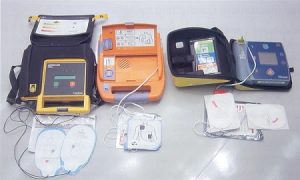Operate an Automated External Defibrillator

Operate an AED
The automated external defibrillator (AED) is a computerized medical device. An AED can check a person’s heart rhythm. It can recognize a rhythm that requires a shock. And it can advise the rescuer when a shock is needed. The AED uses voice prompts, lights and text messages to tell the rescuer the steps to take.The majority of people who survive a cardiac arrest are resuscitated from ventricular fibrillation (VF) by the administration of a defibrillatory shock. This is most likely to be successful when it is given very soon after the onset of VF; emergency service personnel are often unable to arrive soon enough to help a victim.
Automated external defibrillator (AED) is designed to be used by members of the public and are very effective at guiding the operator through the process of administering the shock. They have become widely available, are safe and easy to use, and will not allow a shock to be given to a victim who does not require one.
AEDs have been used frequently by laypeople with modest training, and many reports testify to the success of this strategy. Operators without formal training have also used AEDs successfully to save lives.
Why are AEDs important?
AEDs make it possible for more people to respond to a medical emergency where defibrillation is required. Because AEDs are portable, they can be used by non-medical people. They can be made part of emergency response programs that also include rapid use of EMS number and prompt delivery of cardiopulmonary resuscitation (CPR). All three of these activities are vital to improving survival from cardiac arrest.
Who can use an AED?
Non-medical personnel such as police, fire service personnel, flight attendants, security guards, and other lay rescuers who have been properly trained can use AEDs.
Are AEDs safe to use?
Operate an AED – AEDs are safe to use by anyone who’s been trained to operate them. Studies have shown that 90 percent of the time AEDs are able to detect a rhythm that should be defibrillated. And 95 percent of the time they are able to recommend NOT shocking when the computer shows defibrillation is not indicated.
How does an AED work?
A built-in computer checks a victim’s heart rhythm through adhesive electrodes. The computer calculates whether defibrillation is needed. If it is, a recorded voice tells the rescuer to press the shock button on the AED. This shock momentarily stuns the heart and stops all activity. It gives the heart the chance to resume beating effectively. Instructions guide the user through the process. AEDs advise a shock only for ventricular fibrillation or another life-threatening condition called pulseless ventricular tachycardia.
Operate an AED
Respond Right Australia Courses:
- Basic First Aid
- Provide CPR
- O2 Provider – O2 Administration
- AED
- Apply First Aid
- Apply Advanced First Aid
- One on One Training
We provide all the learning equipment including first aid mannequins, bandages, AED and O2 unit. To save you time we offer an home study learning component so you can complete before you commence training with us.
As a mobile training provider we are able to run courses where you want them, when you want them. Or join us at our location for your training needs. Our courses are delivered in a friendly, fun, relaxed manner, using the highest quality training equipment and course resources.

